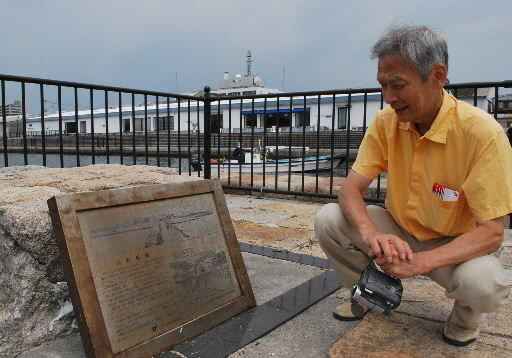Following in his late brother’s footsteps
Aug. 3, 2010
by Yoko Nitta, Staff Writer
His brother lay sick in bed, dying of an unidentified disease seven years after his exposure to the atomic bomb.
On July 30, Shunji Fujimori, a Kyoto resident, walked through Hiroshima carrying diaries in which his brother recorded his sorrow from his sick bed and photo albums. The trip to Hiroshima was made to console his brother's soul, as he was unable to return to the city despite his wish to come here.
Mr. Fujimori's brother, Hideo, was drafted into the military on May 5, 1945, and assigned to Hiroshima. On August 6, he experienced the bombing from his post at the building in Ujina, in the southern part of the city, which contained the Marine headquarters. After the blast, Hideo was reportedly engaged in relief efforts. In November 1945 he returned to Kyoto, but soon after fell ill and became bedridden. He died in 1952 at the age of 26.
In the diary Hideo always kept with him, there was an entry dated August 6: "A gas tank was hit (it seems), smoke billowed into the sky, and the ground was swallowed up in a sea of fire." Though Hideo did not know the cause was an atomic bomb, he wrote about the devastation in the aftermath of the blast in pencil. On the cover of the photo album, which bears a picture postcard of the Marine headquarters building, Hideo also noted that the structure was severely damaged.
After a Buddhist memorial service in 2001 to observe the 50th anniversary of Hideo's death, Mr. Fujimori read his brother's diaries. He was able to locate a woman in Hiroshima his brother had written about with fondness in one of the journals. Mr. Fujimori was in touch with her, through letter and telephone, until she died this year. "I was troubled over the fact that my brother could not visit Hiroshima again. I've finally realized the dream I had held for a long while of bringing his soul to Hiroshima," he said happily.
Mr. Fujimori walked through a park in Ujina, the site where the ruins of the Marine headquarters building were demolished in 1974. He also walked along the area where the military wharf had once been. As he videotaped the sights, tears came to his eyes.
(Originally published on July 31, 2010)
His brother lay sick in bed, dying of an unidentified disease seven years after his exposure to the atomic bomb.
On July 30, Shunji Fujimori, a Kyoto resident, walked through Hiroshima carrying diaries in which his brother recorded his sorrow from his sick bed and photo albums. The trip to Hiroshima was made to console his brother's soul, as he was unable to return to the city despite his wish to come here.
Mr. Fujimori's brother, Hideo, was drafted into the military on May 5, 1945, and assigned to Hiroshima. On August 6, he experienced the bombing from his post at the building in Ujina, in the southern part of the city, which contained the Marine headquarters. After the blast, Hideo was reportedly engaged in relief efforts. In November 1945 he returned to Kyoto, but soon after fell ill and became bedridden. He died in 1952 at the age of 26.
In the diary Hideo always kept with him, there was an entry dated August 6: "A gas tank was hit (it seems), smoke billowed into the sky, and the ground was swallowed up in a sea of fire." Though Hideo did not know the cause was an atomic bomb, he wrote about the devastation in the aftermath of the blast in pencil. On the cover of the photo album, which bears a picture postcard of the Marine headquarters building, Hideo also noted that the structure was severely damaged.
After a Buddhist memorial service in 2001 to observe the 50th anniversary of Hideo's death, Mr. Fujimori read his brother's diaries. He was able to locate a woman in Hiroshima his brother had written about with fondness in one of the journals. Mr. Fujimori was in touch with her, through letter and telephone, until she died this year. "I was troubled over the fact that my brother could not visit Hiroshima again. I've finally realized the dream I had held for a long while of bringing his soul to Hiroshima," he said happily.
Mr. Fujimori walked through a park in Ujina, the site where the ruins of the Marine headquarters building were demolished in 1974. He also walked along the area where the military wharf had once been. As he videotaped the sights, tears came to his eyes.
(Originally published on July 31, 2010)








